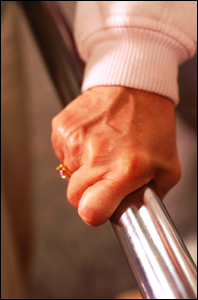 Preventing Falls
Preventing Falls
Aging Well, Living Well Home > Preventing Falls
As you get older, your chances of falling and breaking a bone increase. This is true for many reasons. For one, keeping balanced becomes more difficult as vision, hearing, strength, and coordination begin to decline with age. Some illnesses, such as diabetes, can affect balance. Certain medicines you take make you feel dizzy. Also, like many older women, you may have osteoporosis. Osteoporosis makes your bones weak, which means you can break a bone with even a minor fall.
Falls do not have to happen. There are many things you can do to prevent falls, such as:
- Get a Bone Mineral Density (BMD) Test. Ask your doctor to do a BMD test. This test tells you how strong your bones are. If your bones aren't strong enough, your doctor can prescribe medicine that will help make your bones stronger and harder to break.
- Work with your doctor to develop an exercise plan. Regular exercise makes your muscles stronger, which will help you maintain balance and keep from falling.
- Have your vision and hearing tested. Have your doctor test your vision and hearing often. Seeing and hearing well will help you to keep your balance.
- Know your medicine. Find out about the possible side effects of medicines you take. Some medicines might affect your coordination or balance. If so, ask your doctor what you can do to reduce your chances of falling or if a different medicine might be better for you.
- Limit the amount of alcohol you drink. Even a small amount can affect your balance and reflexes.
- Stand up slowly after eating, lying down, or resting. Getting up too quickly can make you feel faint.
- Don't let your home get too cold or hot. Either extreme can make you dizzy.
- Use a cane, walking stick, or walker when you walk. This is very important when you're walking in areas you don't know well or in places where the walkways are uneven. Be very careful when walking on wet or icy surfaces.
- Wear rubber-soled, low-heeled shoes that fully support your feet. Wearing only socks or shoes with smooth soles can be unsafe, particularly on stairs or waxed floors.
- Hold the handrails when you use the stairs.
- Don't take chances. Don't walk across a recently mopped floor. And don't stand on a chair or table to reach something that's too high — use a "reach stick" instead. Reach sticks are special grabbing tools that you can buy at hardware or medical supply stores.
- Think about buying a home monitoring system service. Usually, this service involves wearing a button on a chain around your neck. If you fall or need emergency help, you just push the button to alert the service. Emergency staff is then sent to your home. You can find local "medical alarm" services in your yellow pages.
Make Your Home Safe
Did you know that most falls happen in the home? Make sure your home is safe with these tips:
In stairways, hallways, and pathways:
- Make sure there is good lighting with light switches at the top and bottom of the stairs.
- Keep areas where you walk clear.
- Check that all carpets are fixed firmly to the floor so they won't slip or cause you to trip. Put no-slip strips on tile and wooden floors. You can buy these strips at hardware stores.
- Have handrails on both sides of all stairs — from top to bottom — and be sure they're tightly fastened.
In bathrooms and powder rooms:
- Mount grab bars near toilets and on both the inside and outside of your tub and shower.
- Place nonskid mats, strips, or carpet on all surfaces that may get wet.
- Keep nightlights on.
In your bedroom:
- Put nightlights and light switches close to your bed.
- Keep your telephone near your bed.
In other living areas:
- Keep electric cords and telephone wires near walls and away from walking paths.
- Tack down all carpets and area rugs firmly to the floor.
- Arrange your furniture (especially low coffee tables) and other objects so they are not in your way when you walk.
- Make sure your sofas and chairs are a good height for you, so that you can get into and out of them easily.
If You Do Fall
If you do fall, don't panic! Do not try to get up too quickly or in the wrong position, which can make an injury worse. Remember, how you react after falling can cause more injuries than the fall itself!
Instead, take a few deep breaths, assess the situation, and decide if you are hurt. If you think you are hurt, do not try to get up. Instead, call 911 or get help from a family member. But if you feel strong enough to get up, follow these steps:
- If you can, crawl to strong, stable furniture like a chair, and pull yourself up. Approach the chair from the front and put both hands on the seat.
- Slowly, begin to rise. Bend whichever knee is stronger. Keep your other knee on the floor.
- Slowly twist around and sit in the chair.
Source: American Academy of Orthopedic Surgeons
![]() You may need to download a free PDF reader to view files marked with this icon.
You may need to download a free PDF reader to view files marked with this icon.